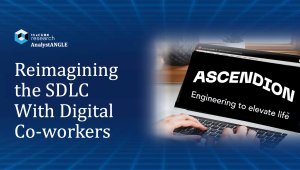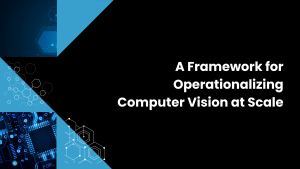An AnalystANGLE breaking down the Consumer Electronics Show (CES) 2024. CES highlighted groundbreaking advancements in technology, emphasizing AI and sustainability, and brought a lot of enterprise tech marketing to the table. This analysis delves into these themes, illustrating their impact through examples from key players in the industry. It reflects on how these trends are reshaping consumer and enterprise technology landscapes.
Introduction to CES 2024
CES 2024 marked a significant return to form, with 135,000 attendees, signaling a resurgence in the tech industry’s premier event. The conference showcased innovations with a strong focus on Artificial Intelligence (AI), sustainability, and the evolution of enterprise tech marketing. These themes not only demonstrated technological progress but also reflected a deeper integration of tech in various aspects of business and daily life.
AI Eats the World
AI was the cornerstone of CES 2024, manifesting in diverse applications that used AI in different ways. Here I will dig into what is meant by AI in a number of applications I found very interesting.
True pet smarts for pet owners
Blovo Animal Health & Lovo Tales is working towards revolutionizing pet healthcare by integrating AI. This will enable easy access to veterinary services and efficient management of pet health data using ChatGPT. With this, pet owners can easily access veterinary care services and maintain their pets’ health data, which will lower the cost of pet care and give them greater control over their animals’ data. The use of ChatGPT for summarization and adding context to the pet’s health information makes it easier to understand, which is a great use of API-based leverage of a foundational model. This also makes it sustainable for a small company.
AI in the bedroom
From DeRUCCI, the T11 Pro Smart Mattress uses its own general AI model, not an LLM, to look for health anomalies based on the data from the sensors and what it knows about you. It not only helps you with problems like snoring but also looking at other health indicators, such as temperature and movement, to help you reach a deeper sleep. Doing inference at the edge, in the bedroom, to achieve the results. It is a general model that gets fine-tuned and deployed at the edge to take actions, such as inflating or deflating part of the air mattress.
Software-defined Automotive and AI Applications
We had a discussion with Sandip Ranjhan CEO from cerebrumx in the Blackberry booth, about how AI needs to be at the car level, bringing AI to the data. We agreed training and tuning will be done in the cloud. Many use cases, such as risk determination in the insurance industry, will be able to leverage this inference and data summarization at the edge. Again, this is not GenAI at the edge, although GenAI might be used in coordination to answer questions based on the AI at the edge in the car.
Many Flavors of AI in Manufacturing
During our conversation with IBM, we discussed the applications of AI in manufacturing, supply chain management, and sustainability. Jose Favilla shared his insights on where and how AI models should exist, highlighting the significance of governance and security. We also talked about the importance of bringing AI to the data instead of vice versa, to optimize industrial processes and preventive maintenance. We noted that foundational models across industries don’t necessarily need to differ, but data will always vary. Again, these were not LLMs per se but models that might be used in coordination with LLMs. Multi-modal AI was a major theme.
During a briefing with AWS, we discussed how the manufacturing industry is an ideal space for AWS and the cloud operating model to partner with third-party hardware. Users can download and install this hardware on industrial computers or gateways with either Linux or Windows operating systems. Alternatively, users can use AWS-specific hardware such as Outposts or Snow Family. The briefing also included a deep dive into AWS IoT SiteWise Edge and how the configuration process is streamlined through the AWS IoT SiteWise console. This allows users to select data sources like sensors on industrial equipment and apply pre-defined or custom functions for data sampling and metric computation. Finally, we also discussed the announcements made at re:Invent and how AWS is leveraging ML at the edge and LLMs in Amazon Bedrock for manufacturing.
AI for sensing beyond perception
We had a meeting with Natalya Lopareva, the CEO of Algorized, in the SwissTech section of Eureka Park, to see a demonstration of their AI-powered remote sensing software. This software goes beyond the traditional perception limits and provides a complete understanding of objects and individuals in any setting. During the demonstration, they showed how it could sense respiration in a vehicle and differentiate between adults and children. They also demonstrated its application in rooms of a building, which is helpful in highly secure environments such as skiffs. They mentioned that the software runs on ultra-wideband chips and seamlessly integrates with Qorvo’s Ultra-Wideband Radar chip to enhance accuracy and reliability. This was super interesting in that the chips were not the story and readily available, the software was the story.
Accessible and accurate data is core to AI
During the visit to SwissTech in Eureka Park, the team came across Stacksync, a startup helmed by Ruben Burdin (CEO) and Alexis Favre (CTO). The company’s primary focus is to establish a bi-directional sync between CRM systems like Salesforce, Microsoft Dynamics, and HubSpot, and databases such as Snowflake, BigQuery, and MongoDB. With this two-way sync, DBAs can make necessary changes in the database using SQL, and the updated information will show up in the CRM system, resulting in a single source of truth. While they were not pushing the AI agenda, it is important to have this data clean and connected if you are building a Customer360 view and building AI-based data products on top.
Accessibility powered by AI
Another startup in the Eureka Park European Innovation Council area that was personally fascinating was Dot Lumen, which has taken the AI for self-driving cars and built a lightweight headset with haptic responses to guide low vision or blind people while walking through the streets or in this case around a busy CES floor. This, to me, was one of the best uses of AI for sensing to all for mobility and accessibility that has only been available for blind or low vision using guide dogs. Again, this goes beyond the use of GenAI to apply AI to a significant issue.
Sustainability: A Core Marketing Tenet
Sustainability emerged as a critical theme, especially for companies marketing outside the U.S. It was clear that you cannot sell in the rest of the world without having a sustainability message.
There were several interesting advancements in sustainability tech at the show. Mobile off-grid power in solar and wind was popular, along with battery-based backup power for homes instead of whole home generators. There were also many improvements in home appliances, particularly in terms of efficiency. One standout product was the GE Profile Combo washer dryer, which used breakthrough heat pump technology and was ventless. The biggest advancement was that it could wash and dry a king-size comforter in under three hours.
These instances underscore the growing importance of sustainability in product development and corporate strategy.
Enterprise Tech Marketing: Bridging B2B and B2C
We noticed a significant change in enterprise tech marketing, where B2B strategies are now being effectively used to market features in B2C products. One of the biggest examples of this shift was the “software-defined automobile,” which was prominently featured in Blackberry’s booth and many others. While the concept of AI was being promoted by many companies, the software-defined concept was being integrated into every part of the tech industry. However, some of these companies seemed to be adopting buzzwords without really understanding them, which made their marketing efforts less effective. Many of these industrial and consumer tech companies are still learning the lessons that we have already learned from bringing marketing strategies from one part of the industry to another.
Our ANGLE
At CES 2024, we witnessed a wide range of innovative applications in AI, sustainability, and enterprise tech marketing. What was considered a new innovation just four years ago at CES 2020 is now more advanced and mainstream. We are seeing an increase in the promotion of AI in its various forms. While AI was present at CES before 2024, its rapid evolution is evident. It was good to see that the exhibitors could explain how they were using AI, the security associated with how they were using it, and mostly staying away from overhyping their use. Sustainability was the second most prominent theme, and US tech companies looking to sell abroad should take note. This was real sustainability, with the circular economy, water usage, and renewable power being front and center for many of the exhibitors. We will have to wait and see if simplifying enterprise tech marketing and using it in some B2C applications will continue to be successful.



